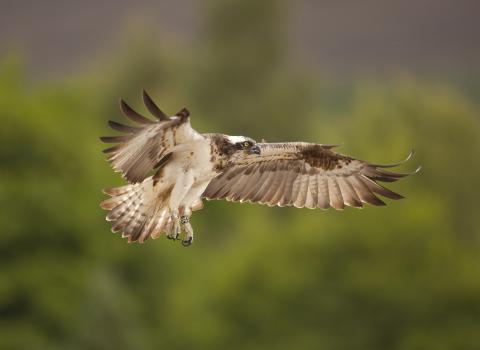For information on upcoming Osprey Watch dates where you can watch the Ospreys at Kielder, please visit our events page.
Ospreys are spectacular fish-eating birds of prey with a wingspan of over five feet. They became extinct as a breeding bird in England in 1840 and in Scotland in 1916 primarily due to heavy persecution by Victorian egg and skin collectors. Although things are slowly improving for ospreys they are still considered rare.
Ospreys re-colonised the UK naturally, breeding for the first time in Scotland in 1954 at Loch Garten, Abernethy Forest Reserve, and in England in 2001 at Bassenthwaite in the Lake District and today there are numerous osprey projects running across the UK to protect these rare and beautiful birds.
A year in the life of Kielder Ospreys (https://youtu.be/hBaWYpPDyKU)
Footage from Forestry England
The Kielder Osprey Project
For many years ospreys were seen passing through Kielder without stopping, always on the way north to more long-standing nesting sites in Scotland. As more and more of the best nesting spots were taken, it was just a matter of time before they stayed south of the border. To encourage this, Forestry England installed a number of platforms around Kielder Forest. This paid off, as following an absence of about 200 years in Northumberland, ospreys returned to nest successfully at Kielder in 2009.
Every year, once the ospreys return to Kielder, Northumberland Wildlife Trust coordinates a team of knowledgeable volunteers who share their expertise with visitors. Osprey Watch is back in 2024 from March with our volunteers based at the Osprey Watch facility at Tower Knowe. The cabin, fitted out with all new interpretation, looks across the reservoir to nest 7, which is beamed back live to a screen. Our team will also be on hand to help you spot the birds on the nest using high powered scopes.
Forestry England continues to provide nest-cameras which enable us to see the nest activity and monitor the ospreys’ progress. The Kielder Osprey blog provides regular updates on how the osprey population at Kielder is faring – click here to read more.
If you are visiting Kielder outside of Osprey Watch, there is still a good chance of seeing these amazing birds. They use all parts of the reservoir, but some favourite areas are either side of the water at the dam, the area between Bull Crag and Leaplish Bay, and Leaplish Bay itself. The ospreys regularly hunt soon after first light and again in the early evening, around 17.30-18.00, but can be active at any time of the day. During early summer, the ospreys will be feeding chicks so you may even be lucky enough to see an adult hunting for food for the young.
The Kielder Osprey project is a partnership between Kielder Water & Forest Park Development Trust, Forestry England, Northumberland Wildlife Trust, Northumbrian Water and Wild Intrigue.
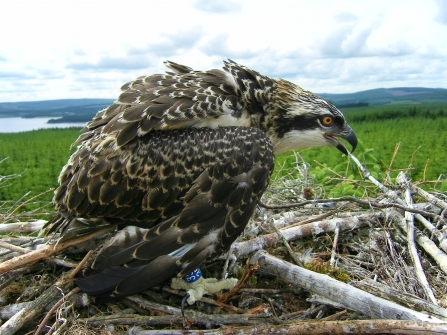
Forestry England
Please show your support for Kielder's ospreys!
Although Osprey Watch is mostly run by volunteers, we still rely on donations in order to complete the work we do, which includes inspiring visitors at the viewing point and osprey cabin, purchasing equipment to help us with osprey monitoring and protection, producing educational materials and training and supporting volunteers.

You can contribute to our work by donating through Northumberland Wildlife Trust’s donation page, choosing Kielder Ospreys in the drop down list. And for a limited time, you can claim a special enamel pin badge when you donate £10 or more to the osprey project. Thank you!
Look out for volunteering opportunities with the project on the NWT website here.
Show your support!
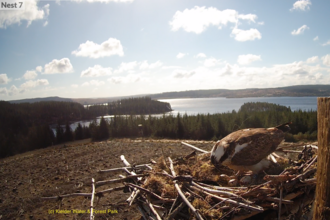
Osprey eggs laid at Kielder for the thirteenth year
Wonderful news from the Osprey Team at Kielder.
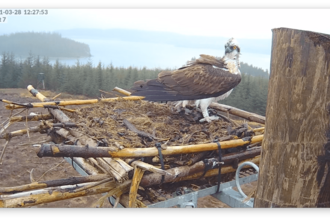
Eyes to the skies and feet on the ground
It’s almost time to tune in to the region’s greatest annual soap opera.
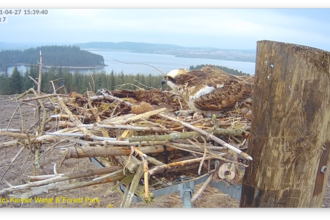
Osprey eggs galore at Kielder
As the nation celebrates the next phase of lockdown easing, there is wonderful news from the team at Kielder.
Partners






